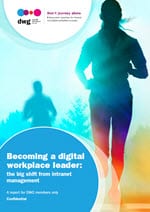My 10 digital workplace predictions for 2016

Before I write my annual digital workplace predictions, I like to look back to evaluate how I think my previous year’s forecast performed. In 2014, I gave myself a “not bad” 7 out of 10 in terms of accuracy and, having now looked back over my 2015 predictions, the good news is I haven’t slipped down my own league table – but the disappointing conclusion is that I have not progressed either. I rate myself as yet another 7 out of 10 in terms of accuracy. I would be delighted to hear in the comments below how you would score me for 2015. Do you agree?
So, before I venture into my forecasts for the key areas to watch for in 2016, here is my rating for the 2015 predictions.
| Prediction 1 | The customer revolution will come from within | ✓ |
|---|---|---|
| Prediction 2 | CEOs will grab the digital workplace as an opportunity for their leadership to be felt at speed and persistently | ✓ |
| Prediction 3 | The digital workplace will extend beyond staff/contractors into the supply chain and partners | ✓ |
| Prediction 4 | A new “digital work ethic” based on freedom will begin to permeate the workplace | ✓ |
| Prediction 5 | HR will seize the opportunity to exploit a high-grade digital workplace for recruitment and retention | ✓ |
| Prediction 6 | Many organizations will establish “digital employee experience” programmes | ✓ |
| Prediction 7 | Offices will struggle to find reasons for their existence as the pace of digital innovation advances | ✓ |
| Prediction 8 | Real-time communication systems will pilot enhanced virtual reality-style technologies | ✗ |
| Prediction 9 | Fewer managers will be required as data, knowledge and information moves to frontline staff | ✗ |
| Prediction 10 | Digital fragmentation will begin to be repaired as disparate systems start to work better together | ✗ |
My digital workplace predictions for 2016
1. Employee experience will become the heartbeat of digital workplace strategies
Inside Adidas, what matters for employees, contractors and the wider freelance workforce is what they experience in their daily work while navigating the digital workplace of one of the world’s leading brands. All too often, conversation about collaboration, intranets and the broader digital workplace can focus on technology fragmentation and the fractured digital landscape.
But what really matters to each person in Adidas (and any other organization) is what they experience moment to moment as they try to do their jobs productively, efficiently and enjoyably. As we see more and more user experience units springing up inside companies, the focus will become more heavily accented on the specific digital experiences of people – just as it so often is in the online consumer world.
2. Digital workplace teams will envision new “digital headquarters” that mirror refashioned physical HQs
Recently I had a tour around the beautiful, newly designed HQ of a major financial services giant in London. It was very impressive. I was also lucky enough to visit The Coca-Cola Company’s HQ in Atlanta last week and was captivated by what I saw there too. But while this flurry of innovatively conceived new offices will continue, what will also start to appear is an equivalent “digital vision” that can at least match the attractions of these physical workplaces.
Teams will map out their “digital headquarters” to be “opened” alongside the traditional HQ, with organizations paying just as much attention to the design, beauty and atmosphere of their digital workplaces as they do to creating buildings in which they hope people will want to work. All too often, the technology is merely added to a building rather than being viewed as an extra dimension in which work happens. Digital teams will imagine a “digital HQ” that is as attractive and engaging as the physical one – but free from the gravitational limitations of bricks and mortar.
3. Enhanced intranets as “front doors” into the wider digital workplace will gain importance
It feels as if intranets have been derided ever since they came into existence in the mid-90s but, despite their unfair reputation as repositories of static content, they keep re-inventing and re-imagining themselves at each stage of digital evolution. Not only have regular predictions of their “death” proved wholly inaccurate but, according to Gartner (and as evidenced from DWG’s members too), we are in the midst of an industry-wide revitalization of interest in next-generation intranets.
When Adobe envisages a transformed digital workplace for the company, the entry point into that new digital world of work is an intranet that is beautiful, functional and accessible. The same is true for many large organizations, who are designing new digital worlds of work. The “intranet-driven digital workplace” is a term we in DWG use regularly and this concept will gain ground as intranets innovate yet again.
4. Culture will take an ever more central role in digital workplace success
Increasingly we recognize, understand and are fascinated by the art and science of how we behave in the consumer world. But the world of work has been a “black box” where the motivation behind how people act in work is hidden from view. However, often the biggest blockers or enablers in the digital world of work are cultural, located in how an organization behaves.
Books such as “Work Rules!: Insights from Inside Google That Will Transform How You Live and Lead” by Laszlo Bock are revealing how culture affects the digital workplace and what can be done to influence our behaviour in work. We will see much more attention paid to culture as an area on which to focus during any digital workplace programme.
5. Enterprise search will finally make significant progress due to powerful success stories
For the last 20 years, finding people and content has been a constant frustration inside large organizations. There have been periodic improvements due to better technology, some understanding of content tagging and innovative search practice, but the story for most companies has been one of disappointment and annoyance.
Now based on tangible success stories from the likes of EY, Verizon and The Coca Cola Company we are beginning to see that search can be significantly better than “the norm”. These best practice examples will stimulate others to direct resources (both human and technical) towards raising the bar for enterprise search, and substantial progress will be made.
6. Disappointing digital workplaces will harm recruitment, retention and engagement
So, your new employer, from its website and on social media seems good… but when you start on Day One and fire up the technology, your heart sinks and the digital disappointment kicks in. For a new younger workforce, in an era of skills shortage, the quality of your digital workplace matters a lot.
To attract, retain and – perhaps most crucially – fully engage a new hire, the power of your digital workplace will increasingly be a “deal breaker”. Yes, a new hire will take the job and start, but if the technology pains them, they will leave sooner and contribute less. For HR, the criticality of the digital workplace will rise in importance and its quality (or lack of it) will become a leadership issue.
7. Microsoft’s dominance will open the way for viable alternative technologies
No one likes a lack of competition or a sense of monopoly and many large enterprises feel that so long as Microsoft remains the number one player in digital workplace technology, its position will bring as much frustration as it does value. Too often I hear the words “We are a Microsoft shop” as if all other “shops” are off limits. This situation fosters resentment and degrades innovation.
This desire for viable alternatives that can operate at scale (such as Google for Work, Adobe Experience Manager, Jive and the new offering from Facebook – recently deployed within 100,000-person Royal Bank of Scotland) will provide realistic alternatives to Microsoft. In the short term, Microsoft will remain the biggest provider of collaboration, intranet and digital workplace services, but its position will be challenged persistently (and with more success) by not only Google, Facebook, Adobe and Jive but by the other 500 or so enterprise technology vendors as well.
8. Governance, strategy and measurement will set the world’s best digital workplaces apart from the rest
IKEA is a world leader in digital workplace ambition and achievement. This is partly due to its focus, culture and insight, but also because it treats strategy, governance and measurement as essential. Too often a digital workplace fit for the future is regarded as being purely about app stores, mobile and productivity tools – but whatever is created must be well managed and led.
Policy, content and governance are all areas to which the best organizations pay close attention. This may not be as seductive as the latest shiny new mobile interface, but getting governance, strategy and key measures right will enable sustained digital workplace progress.
9. Mobile workers will have deeper knowledge in their own hands digitally – further reducing and replacing many managers
When Verizon focused on mobile services for its staff, it created an environment dedicated to content and processes that people would expect and want to use while on the move. This placed valuable data and knowledge in the hands of anyone, irrespective of where they were working physically.
This shift to giving mobile workers high levels of knowledge directly is a transformational one. Whether the worker is one of the 300,000 consultants at Accenture (now considered by its CEO to be a “virtual organization”) or a driver with DHL, having direct access to what matters gives him or her power. The forecast for management is not good as this “digital empowerment” makes the role of managers less central.
10. Our concept of the digital workplace will expand to include “machine to machine” (non-human) relationships
I have spoken for three years now about what I have called the “Human-centred digital workplace” and this has been useful in enabling DWG members and consulting clients to place people at the heart of their digital workplace vision and strategies. But organizations are realizing that when they consider the digital workplace, a large volume of what happens has no human involvement at all. In this area, machines interact with machines, mainly through software working with software.
As digital innovations expand and hybrid systems, artificial intelligence, virtual worlds and robotics increase in their remit, the notion of the digital workplace will have to include the “non-human” systems where work happens. This reality is already here in all we do but, in 2016 (well, maybe a few years beyond that in truth), an expanded digital workplace understanding will be needed.
Related research
[one_half]
[/one_half] [one_half_last]
[/one_half_last]
See also
Is your digital workplace fit for the future?
My 10 digital workplace predictions for 2015
Other digital workplace expert blog posts
Categorised in: Digital workplace, Future of work


